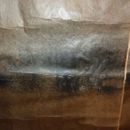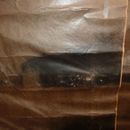Vapor barrier in bathroom remodel
Hi,
I am in the middle of a bathroom remodel. My house was built in the late 60s and is located in climate zone 6 (Quebec). My question is about the damaged kraft paper that is supposed to act as a vapor barrier. From what I can see the wall assembly is (from the interior):
– Drywall
– Kraft paper
– Furring strips
– Some cardboard fiber and studs
– Probably batts insulation (I can’t see behind the cardboard)
– Tar paper and exterior sheeting (brick)
Some of the drywall had little mold spots and the kraft paper is black near the furring strips (see attached pictures). Is this mold?
The kraft paper is not sealed with tape and has perforations from the nails used to hang drywall. I have read this GBA post https://www.greenbuildingadvisor.com/blogs/dept/musings/do-i-need-vapor-retarder
which makes me think that I do not need a vapor barrier at all.
If this is true will the drywall make a sufficient air barrier or should I replace the kraft paper with some other type of material?
Otherwise, I could replace the kraft paper it with foil faced kraft paper (which I aready have) but then it would be in directy contact with the drywall unless I remore the furring strips before applying the the vapor barrier which I think is the way it is done by builders nowadays since it does leave the air gap required by the reflective barrier.
Would it be OK to install foil faced kraft paper on the furring strips to act as an air and vapor barrier?
GBA Detail Library
A collection of one thousand construction details organized by climate and house part












Replies
Guillaume,
The kraft paper is a perfectly adequate vapor retarder. I wouldn't worry about the black discoloration; that's probably just black asphalt bleeding through the kraft paper.
This type of wall assembly needs a good air barrier, but it doesn't need a vapor barrier -- only a vapor retarder, which you already have. (The drywall can act as an air barrier, as long as you follow the Airtight Drywall Approach. For more information, see Airtight Drywall.)
However, building inspectors in Quebec may insist on a polyethylene vapor barrier, even though it isn't necessary. If you end up installing a polyethylene vapor barrier to satisfy a building inspector, your wall assembly will probably be OK in your climate -- but if the house is air conditioned during the summer, it really shouldn't have interior polyethylene.
You don't really need interior furring strips on this type of wall. If you want to improve the R-value and the thermal performance of the wall, you can install a layer of rigid foam on the interior of the studs, followed by drywall. If you decide to do this, you can either install furring strips on the interior side of the rigid foam, followed by drywall, or you can screw the drywall to the studs through the rigid foam with long screws.